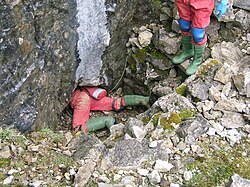| Ogof y Daren Cilau | |
|---|---|
 Caver crawling into entrance Caver crawling into entrance | |
| Location | Llangattock escarpment |
| OS grid | SO20521530 |
| Depth | 192 m (630 ft) |
| Length | 27 km (16.8 mi) |
| Entrances | 2 |
| Difficulty | tortuous entrance series |
| Access | free |
| Translation | Cave of the outcrop with nooks (Welsh) |
| Cave survey | zoomable plan drawing |
Ogof y Daren Cilau is a cave system in the limestone escarpment on Mynydd Llangatwg (Llangattock Mountain), which is south of Llangattock village and above Crickhowell in south Powys, Wales. The escarpment is the remnant of quarrying that had begun by the mid-18th century and initially provided limestone for building and agriculture as a fertiliser, and subsequently for the blast furnaces of the local ironworks as a flux. The cave system was discovered in 1957 and is one of the longest in the United Kingdom. The system is next to the Ogof Agen Allwedd system.
The cave
Ogof y Daren Cilau is one of the longest cave systems in the United Kingdom (over 26 kilometres/16 miles in total) and the entrance section is long, tight and strenuous, making the trip into the further parts of the cave a serious undertaking. Its awkward 517-metre (1,696 ft) entrance crawl is a natural barrier to any casual visitor and precludes the need for a locked gate to protect it from vandals. Highlights of Daren Cilau include the "Time Machine", the largest cave passage in Britain; the "White Company", a set of pure white stalactites; and the "Bonsai Tree", a branching helictite.
Because of the extent of the passages several kilometres from the entrance which would require trips of up to 20 hours to explore, some permanent underground camps have been established, including the "Restaurant at the End of the Universe", which is some thirteen hours from the entrance.
History
Reed (1961) is an extremely informative early source.
The entrance to the cave was discovered in 1957 by Vic Howells of the former British Nylon Spinners Caving Club of Pontypool (which was associated with the British Nylon Spinners factory in Mamhilad). Further investigation and the removal of debris showed an entrance in which a pool of water accumulated. In the ensuing period, the water was drained away and a 400-foot (120 m) passage was revealed ending in a boulder choke. The major breakthrough into the system beyond the entrance series occurred in 1984, before which the cave consisted of little more than the entrance series and several uninspiring passages. In 1986 Martyn Farr connected the Terminal Sump to Elm Hole in the next valley by cave diving.
After decades of work and numerous cave digging projects, a connection to the nearby cave Ogof Agen Allwedd has yet to be found, even though they are only 75 metres (246 ft) apart at their closest point.
Notes
- "Llangattock Escarpment, Brecon Beacons National Park, Powys". uksouthwest.net. Retrieved 24 November 2023.
- Eynon (2000: 19)
- ^ "Ogof Daren Cilau". Caves of South Wales. Retrieved 28 April 2016.
- ^ "An Introduction to Daren Cilau". Daren Cilau. Retrieved 28 April 2016.
- The index of the issue of Brycheiniog in which this source was published listed its author as 'Llangattock Local History Society' and its title as 'Llangattock parish scrap-book'. The entry for Reed (1961) under 'Further reading' below documents the information about the source that was published within the journal, which included an editor, the Rev. Arthur Reed, Llangattock Rectory, and a formal title, both of which befitted its length. Pages 126 to 129 are particularly relevant in the current context.
- "Ogof Daren Cilau". Daren Cilau. Retrieved 28 April 2016.
Further reading
- 1961. Reed, Arthur. "A geographical, historical, and sociological survey of the parish of Llangattock, Crickhowell, Brecs., covering the years 1851 to 1951. Volume One". Brycheiniog. VII: 117-157.
- 1989. Smart, Peter L.; Gardener, Clive G. "The Mynydd Llangattwg cave systems". In Ford, Trevor D. (ed.). Limestones and caves of Wales. ISBN 978-0-521-32438-0.
- 2000. Eynon, Gavin Thomas. Llanelly Parish, Breconshire: The impact of the iron industry on a rural Welsh parish, 1790-1890. MPhil thesis. The Open University. https://oro.open.ac.uk/65433/
External links
51°49′50″N 3°09′17″W / 51.83064°N 3.15479°W / 51.83064; -3.15479
Categories: